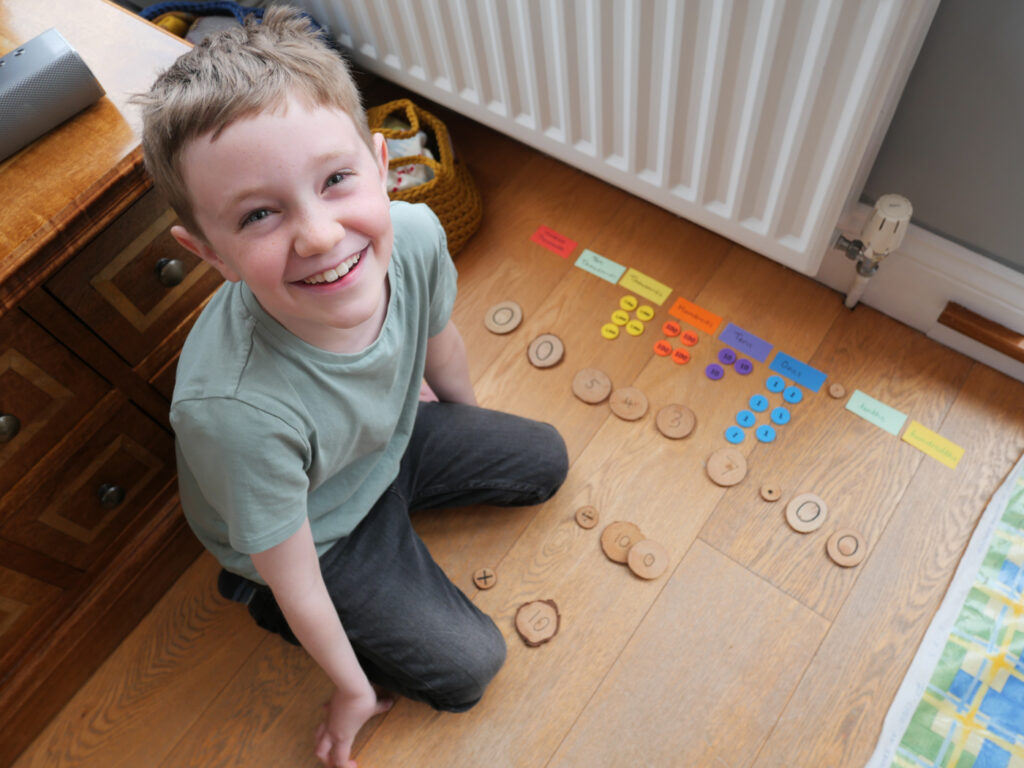Today we were looking at decimals. We started off with a quick recap on place value.






Multiplying by 10
Finny moved all the numbers in 5,437 one place to the left to multiply by 10. This gave him 34,370.












Multiplying by 100
Ioan then reset the numbers and this time he multiplied 5,437 by 100. By moving the numbers two columns to the left, he got an answer of 543,700.









Dividing by 10
Finny divided 5,437 by 10 by moving all the numbers one place to the right, giving him 543.7.












Dividing by 100









Converting fractions to decimals
As Cian’s frog obsession has taken over the house, we decided to use frogs as our theme for today’s maths. The following activity was Ioan’s idea.
We used frog jumps to help us convert whole numbers and fractions in to decimals. The length of the pond was like a number line, with the lily pads being placed at equal distances from each other across the pond.
In true Finny style, he had named all the frogs.















1 leap
As shown with Leaf the frog‘s ‘big jump’ below, the log was the starting point and represented zero, with the leaf at the end representing one. Ioan had to record 1 whole number as a decimal.












10 leaps
Park Frog was jumping in 10 jumps, making each leap one tenth, so Finny had to record that as a decimal.









5 leaps
Hunter was jumping in 5 jumps, so each of his leaps was equivalent to two of Park Frog’s. This made each leap two tenths. Ioan recorded this as 0.2, which is also one fifth.









2 leaps
Peter Andre (with his froggy six pack) was doing two jumps and one half is 0.5.









4 leaps
Fierce Frog was doing four jumps, so each jump was one quarter, or 0.25 as decimals.









Halves and quarters as decimals
A frog lays 100 eggs…
Unsurprisingly, this was Finny’s idea. Any chance to play with the water bead tadpoles and he’ll take it. Ioan was keen to stick to representing his answers with the base ten.












Ioan recorded the answers they had so far on a number line.















Solving the final question.















Ordering decimals
They ranked the frogs in order from the longest jump to the shortest jump. To do this they had to sort the decimals into descending order from the largest decimal to the smallest.






Equivalent decimals
Ioan noticed that the way the pond was set out looked like a fraction wall.
What is a fraction wall?
In a fraction wall, each separate layer or row depicts one whole number. Each layer then divides into the fractions that represent the whole number.
For example, the first row is a whole. The second row is in halves. The fourth row in quarters, etc.
Ioan spotted that two jumps for Park Frog were equivalent to one jump for Hunter. They were both 0.2.
Finny pointed out that 5 jumps for park frog was the same as 1 jump for Andre and two jumps for Fierce frog. They were all 0.5.









They also sotted that 8 jumps for Park Frog was the same as 4 jumps for Hunter. They both equalled 0.8 as Hunter jumps twice as far each leap.






DfES National Curriculum (2013)
Numeracy Year 4 programme of study
Number – fractions (including decimals)
- recognise that hundredths arise when dividing an object by one hundred and dividing tenths by ten
- find the effect of dividing a one- or two-digit number by 10 and 100, identifying the value of the digits in the answer as ones, tenths and hundredths
- recognise and show, using diagrams, families of common equivalent fractions
- recognise and write decimal equivalents of any number of tenths or hundredths
- recognise and write decimal equivalents to one quarter, a half, three quarters













